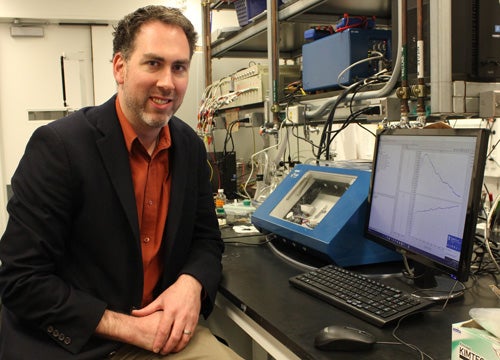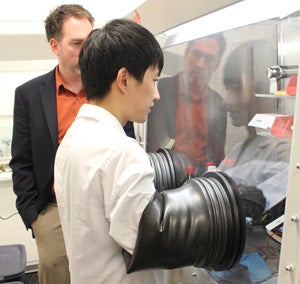
Supercapacitors: a promising, green alternative to traditional batteries
Creating smartphones that fully charge in a matter of just five or 10 seconds

Creating smartphones that fully charge in a matter of just five or 10 seconds
By Brian Caldwell Faculty of Engineering Michael Pope doesn’t know how much daily battery life people would be willing to trade away for the convenience of smartphones that fully charge in a matter of just five or 10 seconds.
Michael Pope doesn’t know how much daily battery life people would be willing to trade away for the convenience of smartphones that fully charge in a matter of just five or 10 seconds.
But after using nanotechnology for a recent breakthrough in the design of energy-storage devices known as supercapacitors, the Waterloo Engineering professor expects that question to become increasingly relevant in the case of cellphones, laptops and a wide range of other potential uses.
“If they’re marketed in the correct ways for the right applications, we’ll start seeing more and more of them in our everyday lives,” Pope says.
Supercapacitors are a promising, green alternative to traditional batteries. Their advantages include rapid charging and discharging, improved safety and reliability, and a much longer overall lifespan.
The drawback is that they have relatively low storage capacity, greatly limiting their practical uses.
Existing commercial supercapacitors only store enough electrical energy, for instance, to power cellphones and laptops for about 10 per cent as long as rechargeable batteries.
The breakthrough by Pope and two collaborators – PhD student Zimin She and post-doctoral fellow Debasis Ghosh – roughly doubles that storage capacity.
The increase means supercapacitors can now be made small and light enough to be considered for more applications, particularly those requiring quick-charge, quick-discharge capabilities.
“We’re showing record numbers for the energy-storage capacity of supercapacitors,” says Pope, a chemical engineering professor. “And the more energy-dense we can make them, the more batteries we can start displacing.”
Even with additional development, supercapacitors are unlikely to approach even half of the storage capacity of batteries, which are also steadily improving.
But given the fact they charge so quickly, that might just be good enough for users to accept plugging in their phones two or three times a day for a few seconds, as opposed to once a day for an hour or more.
The same might be true of electric vehicle drivers and their willingness to sacrifice some range for the ability to fully recharge more often, but in a tiny fraction of the time.
“We have to inch forward in the scientific community,” Pope says of the charging-speed versus energy-storage trade-off.
Doubling the capacity of supercapacitors was achieved using a novel method to coat atomically-thin layers of a conductor called graphene with an oily liquid salt in electrodes.

The liquid salt acts as a spacer to separate the graphene sheets, preventing them from stacking like pieces of paper. That dramatically increases their exposed surface area, a key to maximizing energy-storage.
At the same time, the liquid salt serves as the electrolyte required to actually store electrical charge. That minimizes size and weight.
“That is the really cool part of this,” says Pope. “We think it’s a clever, elegant design.”
Also central to the design is a detergent used to reduce the size of droplets of oily salt in a water-oil emulsion to just a few billionths of a metre, enhancing their coating action. The detergent makes the droplets adhere better as well.
“That sticking action is like chemical Velcro,” Pope says.
Potential near-term applications for better supercapacitors include the replacement of lead acid batteries in traditional vehicles and capturing energy that would otherwise be lost by buses and high-speed trains during braking.
Also possible down the road is the use of supercapacitors to power consumer electronics, lasers requiring sudden bursts of energy, wearable technology with motion-energy harvesters and systems in remote locations such as space where long lifespan would be extremely valuable.
“We provide options and hopefully someone will commercialize this,” Pope says.

Waterloo researcher Dr. Tizazu Mekonnen stands next to a rheometer, which is used to test the flow properties of hydrogels. (University of Waterloo)
Read more
Plant-based material developed by Waterloo researchers absorbs like commercial plastics used in products like disposable diapers - but breaks down in months, not centuries

Read more
Here are the people and events behind some of this year’s most compelling Waterloo stories

Engineering master's student Nayeema Nonta (left), one of the three paper authors, and her supervisor, Dr. Sirisha Rambhatla, in a large server room with the computer power needed to develop their new LLM training technique. (University of Waterloo)
Read more
Waterloo researchers develop highly efficient AI training system that paves the way for cheaper, greener “intelligent partners”
Read
Engineering stories
Visit
Waterloo Engineering home
Contact
Waterloo Engineering
The University of Waterloo acknowledges that much of our work takes place on the traditional territory of the Neutral, Anishinaabeg, and Haudenosaunee peoples. Our main campus is situated on the Haldimand Tract, the land granted to the Six Nations that includes six miles on each side of the Grand River. Our active work toward reconciliation takes place across our campuses through research, learning, teaching, and community building, and is co-ordinated within the Office of Indigenous Relations.